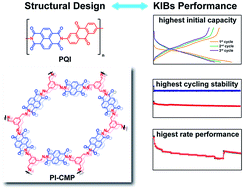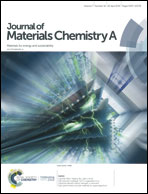Carbonyl-based polyimide and polyquinoneimide for potassium-ion batteries†
Abstract
Although potassium-ion batteries (KIBs) are potentially alternative energy storage systems to lithium-ion batteries (LIBs), only few organic materials can be used as candidate electrodes for KIBs. Herein, we synthesized a class of carbonyl-based organic polymers including two 1D linear polymers, namely polyimide (PI) and polyquinoneimide (PQI), and a 2D conjugated microporous polymer (PI-CMP) as stable organic cathode materials for KIBs. The investigation of their electrochemical performance revealed the structure-property relationship. For instance, the direct connection between two electrochemical active organic molecules could increase the initial capacity; however, the tight distribution of potassiated carbonyl groups might cause rapid capacity fading. In addition, the extended π-conjugation could improve the cycling stability and rate performance. Furthermore, the redox mechanisms with potassium have been fully investigated utilizing FTIR, XPS measurements and DFT calculations, suggesting that the carbonyl group is the potassium-ion binding site with excellent reversibility for KIBs.



 Please wait while we load your content...
Please wait while we load your content...